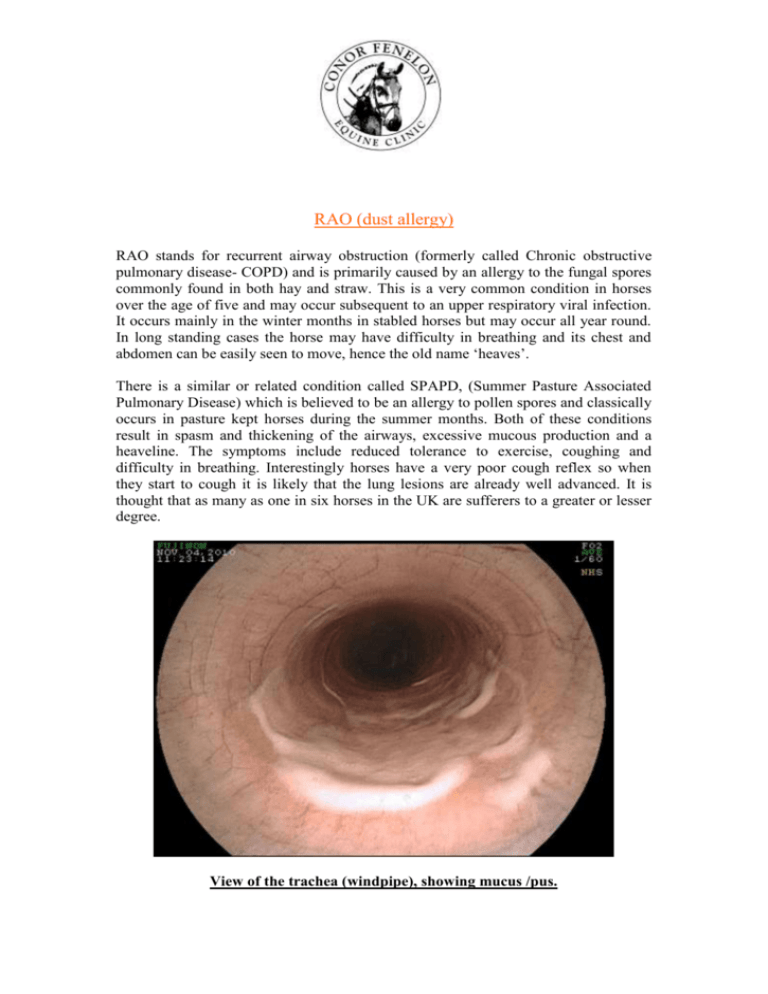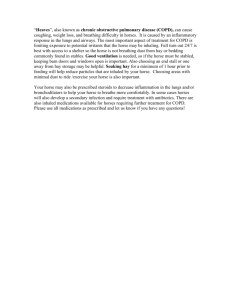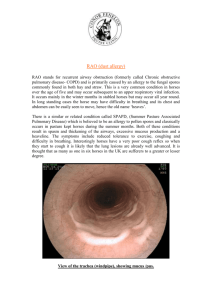RAO (dust allergy) RAO stands for recurrent airway obstruction
advertisement

RAO (dust allergy) RAO stands for recurrent airway obstruction (formerly called Chronic obstructive pulmonary disease- COPD) and is primarily caused by an allergy to the fungal spores commonly found in both hay and straw. This is a very common condition in horses over the age of five and may occur subsequent to an upper respiratory viral infection. It occurs mainly in the winter months in stabled horses but may occur all year round. In long standing cases the horse may have difficulty in breathing and its chest and abdomen can be easily seen to move, hence the old name ‘heaves’. There is a similar or related condition called SPAPD, (Summer Pasture Associated Pulmonary Disease) which is believed to be an allergy to pollen spores and classically occurs in pasture kept horses during the summer months. Both of these conditions result in spasm and thickening of the airways, excessive mucous production and a heaveline. The symptoms include reduced tolerance to exercise, coughing and difficulty in breathing. Interestingly horses have a very poor cough reflex so when they start to cough it is likely that the lung lesions are already well advanced. It is thought that as many as one in six horses in the UK are sufferers to a greater or lesser degree. View of the trachea (windpipe), showing mucus /pus. Unfortunately there is currently no cure for either condition but they can usually be managed so that most horses continue to compete successfully. Drugs can only alleviate the symptoms of RAO. Managing these conditions consists basically of removing your horse from all possible allergens and is fundamental to controlling them. Done properly this will usually result in your horse being to live and compete normally. It is the attention to detail that determines the success of any management changes. This means that with RAO (COPD) we advise that you turn your horse out as much as possible. If stabling is essential we recommend that the building is well ventilated and you bed him on shredded paper /cardboard, good quality shavings or Hempcore. You should only feed good quality hay and soak it well, or preferably feed Propak/ Horsehage (careful with laminitics /good doers). Ideally he should be fed from the ground to promote drainage from the lungs. He should not be in the stable while it is being mucked out and ideally he should be groomed in the open air. Do not exercise in dusty schools etc. Deep litter bedding systems are a very poor choice for these horses. In exceptional cases we advise that some horses with RAO live outside and have access to a field shelter. Steaming hay or feeding Haylage, in our opinion will only help a mildly affected horse. To soak hay effectively we recommend that you immerse it in water for about 20 minutes before feeding it. This does three things to the hay, firstly it washes it, (-look at the colour of the water drained off subsequently), secondly it sticks the spores to the fibres and lastly (and probably leastly) the individual spores absorb water and swell up, making it difficult for them to get down to the critical levels of the lung to cause the reaction in the first place. Conversely with SPAPD we advise that you stable your horse, at least during the day, to keep him away as far as possible from the pollen. As a general principal we would also advise that these horses are bedded on good quality shavings/ shredded paper and fed either soaked hay or Propak/ Horsehage. Rubber stable mats can be very useful in helping to manage these conditions. You should balance the initial expense in purchasing them as against the ongoing cost of alternative bedding. It is also very important that the floor drains well, otherwise urine collects beneath them giving off ammonia which is irritant to the lungs and would aggravate both these conditions. You might need to consider using Biofresh (from Biotal) this is a microbial product, which contains enzymes to block ammonia production. Where rubber mats are used we recommend that you have a very thin layer of shavings to reduce urine splashing and to soak it up subsequently. One major disadvantage of matting is that if horses (especially youngsters) lie down on them then you can considerably reduce the life expectancy of their rugs. When we are asked to medically treat coughing horses we would routinely advise these management changes in addition to any drugs that we give. The best /strongest drugs that we use are either clenbuterol (eg‘Ventipulmen, /Dilaterol’) (which treats the bronchospasm and helps shift the mucous), and/or ‘Sputolosin’ (which is a better drug to shift mucous but has no effect on the bronchospasm). Both these drugs may be fed to your horse. Ventipulmen and Sputolosin are prescription drugs, so that they can only be used after a clinical examination and a diagnosis by a veterinary surgeon. Non-prescription drugs that can be tried in MILD cases include Respadril and Secreta pro. Additionally you can try feeding the food supplement ‘Winergy Ventillate’, this tries to mop up the free radicles, which occur in inflammation. If a horse seems little better after a course of medical treatment, especially where the air hygiene seems good, we currently recommend that we endoscopically examine him and take a tracheal wash from his lungs. This can confirm that the air hygiene management is working and look for any evidence of bacterial infection. In this instance we would put him on a course of the appropriate antibiotics and recheck later to confirm that it has worked. As a general rule we recommend that all horses are rechecked once a course of treatment has been completed, because as stated above absence of coughing is not a reliable sign that an individual horse has made a complete recovery. They may still be suffering from a sub-clinical condition which could increase the chances of recurrence and affect his ability to compete successfully. Where we have adequate air hygiene management and in the absence of a bacterial infection, we would put the horse on a course of corticosteroids. These can be either fed as tiny tablets or inhaled as a powdered mist (just as in human asthmatics), but in this case through a special mask. The latter although it necessitates the purchase of the mask is preferable, as we get maximal drug levels in the lungs without the systemic side effects we normally associate with corticosteroid use (e.g. laminitis). Finally there is another drug Chromoglycate (formerly called ‘Chromovet’), which prevents the release of histamine in the lungs and thus theoretically prevents the spasm and mucous occurring in the first place. This drug is a liquid, which must be inhaled as a mist so in addition to the facemask you need a nebuliser to convert it into a mist prior to inhalation. Some people try various homeopathic remedies with various degrees of success. Finally it might be possible in certain circumstances to take a blood test (RAST test) and try to work out exactly what your horse is allergic to. Then it may be possible to make a vaccine for him, this is still fairly new technology so it might be worth discussing this with the attending vet. Each horse is treated as an individual and so the exact details of your horse’s treatment will probably vary according to his specific needs. In all instances however we will be happy to discuss with you should you have any worries or specific queries you would like addressed. TOP TIP To soak hay, we advise that you purchase a water butt barrel from a garden centre and cut off the top half, retaining the lower half with its tap. Place the hay in sections into the barrel, fill with water and soak for 20mins, then open the tap and allow the water to drain away. Drag the barrel into the stable and allow your horse to his hay from it. This will ensure that the hay does not dry out wetting the bed in the process. Also by feeding from the ground you will promote drainage from the lungs. The Acorns Equine Clinic, Pleshey, Chelmsford, Essex. CM3 1HU. Telephone. (01245) 231152, Fax. (01245) 231601. www.essexhorsevets.co.uk









